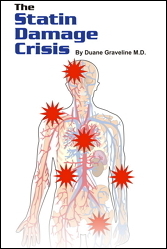Post Menopausal Iron Supplementation - Caution!
Is there a medical doctor anywhere who does not think immediately of estrogen deprivation as the most likely explanation for the well-known spike in coronary heart disease (CHD) incidence in the 6th decade in women after menopause? A recent paper by Agrinier and others in France(1), summarized CHD risk factors in 1730 post menopausal women, revealing surprising information about the possible contribution of iron.
Even while winding down my 23 years of family medicine over a decade ago, I was already aware of a growing incidence of asymptomatic liver enzyme elevation in post menopausal women. Some of this I knew reflected the increasingly widespread use of screening blood tests during that era but I was curious.
Agrinier reported that postmenopausal women had higher levels of total and LDL cholesterol, so consequently and bowing to the effectiveness of four decades of anti-cholesterol brainwashing we speculated that the increase in coronary heart disease risk during the sixth decade could be explained by an effect of estrogen deprivation on lipid profile first being felt in the perimenopausal period.
However more inquisitive minds found growing reasons to challenge this concept or to consider other factors. First of all, premenopausal women are largely protected from coronary artery disease even in the presence of a greatly unfavorable lipid profiles such as that seen both with heterozygous familial hypercholesterolemia and the so-called "elevated" normal cholesterol levels occurring in so many otherwise normal individuals merely by a national cholesterol board calling them elevated.
Additionally, from the Framingham study, when comparing natural menopause data with that from surgical menopause with hysterectomy and surgical menopause with hysterectomy and oophorectomy, it strongly supported the importance of a periodically shedding uterus lining in the protection of premenopausal women.
Finally the iron data were examined. As early as 1981 Sullivan(2) referred to the beneficial effect of iron depletion in menstruating women. In their late teens men begin their steady accumulation of iron stores with age. Women fail to significantly store iron because of their continual losses of iron in their menses.
An escalation of cardiovascular risk in women follows acquisition of significant stored iron after cessation of menses. This risk escalation may be due to the inflammatory effects of stored iron and not elevated LDL cholesterol(3). Supportive of this hypothesis is the observation of fatty liver, elevation of liver enzymes and elevation of serum ferritin in many postmenopausal women, especially those having postmenopausal weight gain.
In many instances these women have continued intake of foods or vitamins supplemented with iron long after menopause and are unknowingly taking in very significant amounts of iron, allowing gradual buildup of excess iron in susceptible tissues. The aforementioned might explain why cholesterol lowering treatment with statin drugs did not reduce the risk of cardiovascular heart disease in these women.
Simply put, their MDs may have been treating the wrong target. Perhaps, the true villain here is iron; cholesterol, as I have said so many times before, is now generally considered to be irrelevant.
In a case much closer to home, my wife was recently found to have elevated liver enzymes with ferritin value some three times the upper limit of normal. Imaging studies revealed her liver to be enlarged and fatty in consistency. During her gall bladder resection for non-functioning gallbladder her liver was reported to be enlarged and fatty in appearance.
None of the usual suspects were evident in the usual lineup and only when I examined closely her ‘one a day' vitamin and mineral bottle did I spot the probable causative factor - each pill included 9 mg of iron. She had been taking this since long before I met her and continued with it after her hysterectomy five years ago. Until then she had been having normal menses and was now unable to rid her body of excess iron.
The blood donor bus is gladly accepting her periodic blood donation now and I am confident that her ferritin and liver will return to normal after a few donations. During my 23 years of family medicine practice, I considered myself a good doctor, but I missed that one.
Incidentally this condition of fatty liver and elevated liver enzymes was first diagnosed as non-alcoholic liver disease (NALD) in the early 1990s. From a review of suspected causes for this new disease ranging from common foods: fructose, to common meds: aspirin, NSAIDS, and corticosteroids, to statin drug use, the words "I do not know the cause" are quick to enter the open mind.
Duane Graveline MD MPH
Former USAF Flight Surgeon
Former NASA Astronaut
Retired Family Doctor
References:
1)Agrinier N, Cournot M, Dallongeville J, et al. Menopause and modifiable coronary heart disease risk factors: a population based study. Maturitas 2009. Dec 21
2)Sullivan JL. Are menstruating women protected from heart disease because of, or in spite of, estrogen? Relevance to the iron hypothesis. Am Heart J 2003;145:190-4.
3)Mascitelli L and others: elsevier.com/locate/maturitas






